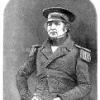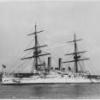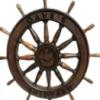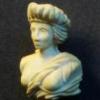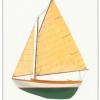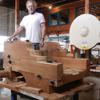-
Posts
1,859 -
Joined
-
Last visited
Reputation Activity
-
 Chuck Seiler got a reaction from GrandpaPhil in Gunboat PHILADELPHIA 1776 by Chuck Seiler - Scale 1:48 - from Model Shipways plans
Chuck Seiler got a reaction from GrandpaPhil in Gunboat PHILADELPHIA 1776 by Chuck Seiler - Scale 1:48 - from Model Shipways plans
I flew some Sailors in to square away the lubberly rigging. Here is where I am as of now.
The swabbies thought the ladder rungs, in lieu of ratlines, were cute, so they left them on. Once I get the starboard gun installed, the rigging will go very fast. Once that is done, the forward railings and awning structure...as well as cats and dogs like anchors, rope coils, sweeps, etc.
I had taken several pics during our Guild meeting Wednesday, but all except this ended up being out of focus. More pics this weekend...if I can see thru the smoke and ash.
-
 Chuck Seiler got a reaction from ccoyle in Gunboat PHILADELPHIA 1776 by Chuck Seiler - Scale 1:48 - from Model Shipways plans
Chuck Seiler got a reaction from ccoyle in Gunboat PHILADELPHIA 1776 by Chuck Seiler - Scale 1:48 - from Model Shipways plans
Philly at the Fair.
I got some horrendous "blooms" from reflection. Sunday (when I am back at the Fair) I will see If I can remove the case and get some shots. Meanwhile, I tried to blot out the worst of them.
I managed to eek out an honourable mention.
-
 Chuck Seiler got a reaction from GrandpaPhil in Gunboat PHILADELPHIA 1776 by Chuck Seiler - Scale 1:48 - from Model Shipways plans
Chuck Seiler got a reaction from GrandpaPhil in Gunboat PHILADELPHIA 1776 by Chuck Seiler - Scale 1:48 - from Model Shipways plans
Wee hours of the Morning, Thursday 29 May. 'Tis mere hours before I have to deliver the model to the County Fairgrounds. All nighters are not as easy as they used to be.
Work on the awning structure is pretty much as complete as it is going to get. I still need to add the rolled up awning, sweep rack and sweeps, but that will have to wait until the Fair is over.
Rigging is complete! Hoist the ensign and we sail into battle!!!
<poop> No sail. We row into battle
<poop> No sweeps. We get towed into battle...Call AAA.
This page will be on hiatus until after July 4th, when I get PHILLY back. I will complete the model and get pics posted.
My intent was to get a good set of shots prior to taking the model to the Fairgrounds from work....but I forgot my camera.
-
 Chuck Seiler reacted to Erebus and Terror in THE BLACKEN-IT TRIALS
Chuck Seiler reacted to Erebus and Terror in THE BLACKEN-IT TRIALS
Thank you everyone for the great comments; they are really appreciated.
Jud and Chuck, your point about the acetone is well taken.
All of this sequential preparation is probably overkill, but from what I've learned it is useful for achieving consistent results, especially when coated brass stock is used.
Apparently the acetone is often employed as a backup-step to remove any hand oils or dirt that might have crept in after the acid bath. However, it will also remove any lacquers or finishes that muriatic acid will not. This is especially important if you don't adequately sand all portions of the metal prior to the chemical treatments.
-
 Chuck Seiler got a reaction from Erebus and Terror in THE BLACKEN-IT TRIALS
Chuck Seiler got a reaction from Erebus and Terror in THE BLACKEN-IT TRIALS
I had the same thought as jud, is the acetone bath really necessary after the muriatic acid bath?
-
 Chuck Seiler reacted to Erebus and Terror in THE BLACKEN-IT TRIALS
Chuck Seiler reacted to Erebus and Terror in THE BLACKEN-IT TRIALS
The Problem:
Anyone who has followed my HMS Terror scratch build may remember my issues with blackening brass fittings for the stern assembly. To briefly summarize, I immersed the parts in a standard 8:1 mixture of Blacken-It solution mixed with bottled water, waited until the parts turned the appropriate colour, then rinsed in bottled water to “neutralize” the reaction. I tried this several times on different parts and each time it resulted in a flaky, blotchy appearance that could not be made even despite buffing with a soft cloth.
Here is an image of my results. Note the blotchy and flaky texture.
Inspired by the fine results of other modellers on the boards, I resolved to master the “mysteries of the blue Liquid”. I began with research; modelers, gunsmiths, jewellers, instrument makers, and mechanics all use various products and processes to chemically blacken metals and a great deal of information is available from forums, blogs, websites, magazines, and books.
With this knowledge at hand, I decided to conduct a series of trials to determine the best process for blackening metal using Blacken-it. I chose Blacken-it as it seems to be the most commonly used product on Model Ship World, and, perhaps more importantly, I had a supply available. However, the techniques I use here should be applicable to other metal blackening products.
Before I outline my tests I should begin with a note on safety:
The chemicals used in the blackening process are dangerous. Rubber gloves, safety goggles, and a well-ventilated room (or fume hood) must be used EVERY time you handle the chemicals.
The Process:
From my research, I learned that producing consistently good results requires seven steps, in this order:
1) The surface of the metal should be mechanically prepared. This roughens the surface and removes synthetic coatings that are often used to give stock metal a shiny appearance.
2) The surface of the metal should be treated with an acid pickle to remove any scale or corrosion.
3) The metal should be cleaned with a solvent to remove organic contaminants such as oils, fingerprints, and other dirt.
4) The metal is chemically coloured using a diluted blackening agent.
5) The reaction should be “fixed” or halted, using a neutralizing solution.
6) The surface of the metal should be buffed to remove excess blackening products and to polish the new surface.
7) The metal should be coated in a protective agent to prevent corrosion, soiling, and damage (optional).
The Equipment:
My research indicates that the following chemicals most often produce consistent results:
1) Muriatic acid (31.4%). This is commonly used to remove scale and corrosion on the surface of the metal. Most hobbyists and professionals use 1:1 concentration of water and acid. Remember, you should always pour the acid into water, as it can be dangerous to pour water directly into acid. You can purchase muriatic acid in most hardware or pool supply stores.
2) Deionized water. This tip was given to me by Druxy on these forums. I’m convinced that the blotchy, scaly results on my first use of Blacken-it were the result of my use of mineral-laiden bottled water. Dionized water is treated to remove mineral ions which could react with Blacken-it. Use the deionised water for all stages of the blackening process, including rinsing between baths, diluting chemicals, and for neutralization.
3) Acetone (100%). This is a widely used degreasing agent employed to remove finger prints, oils, or other organic coatings which might contaminate the metal. It can be purchased at any hardware store.
4) Baking soda. The final stage of the blackening process should include proper neutralization. A common solution is two table-spoons of baking soda in a cup (250 ml) of warm deionised water. Often, hobbyists will use running tap water to neutralize the reaction with good results; baking soda seems to be preferred by jewelers and instrument makers.
Here is a photo of the equipment I used in my tests.
The Tests:
My trials involved testing two variables: 1) the concentration of Blacken-It (undiluted, 1:1, 5:1, or 10:1), and 2) water neutralization versus baking soda neutralization.
The test parts prior to preparation.
Step 1: I thoroughly sanded the surface of my brass test parts with 400 grit sandpaper. This is similar to the preparation of any metal part even if it isn’t going to be painted or chemically coloured.
Step 2: I buffed the metal with ultrafine steel wool. Be certain to carefully remove any steel wool filings that remain as they can react with the chemicals used in the next stages.
The parts after mechanical preparation.
Step 3: Immerse the part in muriatic acid (diluted 1:1 with deionised) water for 30 minutes. You can immerse the parts for longer, but the acid will eventually etch the surface and soften sharp edges and other details if you leave them in too long. You may notice that the pickle will change the colour of the brass or that some corrosion may appear – this is normal and is caused by impurities or inconsistencies in the metal.
Step 4: Rinse each part by agitating vigorously in a bath of deionized water for at least 10 seconds. Allow to dry thoroughly on a clean paper towel. Change the water in the bath for the next step.
Allow the parts to dry thoroughly.
Step 5: Immerse the parts in an acetone bath for 30 minutes.
Step 6: Rinse each part by agitating vigorously in a bath of deionized water for at least 10 seconds. Allow to dry thoroughly on a clean paper towel.
Allow the parts to dry thoroughly.
Step 7: Immerse the parts in the Blacken-it solution. Maximize the surface area of the part exposed to the chemical by placing it on end if you can. Gently, without scratching the surface, turn the part every few minutes to ensure all surfaces are exposed equally to the solution. Carefully monitor colour changes, and remove the part when the desired colour is achieved.
Different concentrations of Blacken-it.
The parts after 30 seconds.
After five minutes.
After 60 minutes (other parts removed when desired colour achieved).
Step 8: Instantly dunk the part in the warm baking soda bath. Agitate vigorously for ten seconds. You will notice that the part will begin to corrode and a blotchy green or red film will cover the surface. Do not worry.
After a bath in the baking soda solution, the part will appear green (or sometimes red).
Neutralizing with water leaves a cleaner surface (but caution is warranted, see below).
Step 8: Carefully buff the part with a clean soft cloth (an old t-shirt works perfectly). Do not touch the part with your fingers. You will notice that the corrosion products resulting from the neutralizing bath will scrub away. Buff until all portions of the part have an even colour; continue to buff if you want a shinier surface.
Buffing the parts fixed in the baking soda solution removes the green/red coating.
After buffing, all the parts appear roughly similar in colour and finish from a distance (see below for differences).
Step 9: Wait 24 hours to ensure the reaction was effectively neutralized. If “sweating” or pitting is noticed, the reaction was not properly neutralized, and a further rinse may be required. Usually the part can be salvaged by buffing with a soft cloth. Sometimes, it may need to be blackened again.
Step 10 (Optional): Spray the parts with a thin acrylic matte coating to protect the surface.
I use Krylon Matte Coat.
The Trial Results:
Undiluted Blacken-It solution:
The undiluted solution produced a very dark, but somewhat uneven black surface in about five minutes. Fixing the reaction with baking soda caused a significant amount of corrosion, but it was mostly removed by buffing.
Undiluted immediately after buffing.
However, after 24 hours both parts began to sweat, indicating that the chemical reaction had not been neutralized even with a baking soda bath. This is not unexpected, as the product guidelines indicate that the product is meant to be diluted.
Undiluted after 24 hours.
Recommendation: Do not use undiluted solution.
1:1 Blacken-it Solution
This is the concentration recommended by the manufacturer. After ca. 10 minutes the part reached a deep black, but after neutralization with baking soda solution the surface appeared to be quite blotchy. After 24 hours the edges of the part began to sweat and corrode and the surface appeared pitted.
1:1 immediately after buffing.
1:1 after 24 hours.
The water neutralized part had a slightly more even surface, but unfortunately began to sweat after only 24 hours.
1:1 unfixed (water neutralization) after 24 hours.
Recommendation: Do not use 1:1 solution.
5:1 Blacken-it Solution
The 5:1 solution required approximately 25 minutes to reach a deep black. Immersion in the baking soda solution initially produced a green corrosion but buffing resulted in an even black surface. The part remained stable after 24 hours (and is still stable a week later).
5:1 immediately after buffing.
5:1 after 24 hours.
The unfixed, water-neutralized part began to corrode at the edges after 24 hours.
5:1 unfixed immediately after buffing.
5:1 unfixed after 24 hours.
Recommendation: Works very well in conjunction with a baking soda rinse.
10:1 Blacken-it Solution
The 10:1 solution required approximately 60 minutes to reach a dark even black. Immersion in a baking soda rinse produced a slight corrosion, but buffing resulted in a very even and deep black surface (in my opinion better than the 5:1 concentration). The part has remained stable after a week.
10:1 immediately after buffing.
10:1 after 24 hours.
Similar results were achieved with the water-only neutralization, and the part remained stable after 24 hours. However, after ca. four days corrosion began to appear at the edges of the part.
10:1 unfixed after four days.
Recommendation: The 10:1 solution performed very well in conjunction with a baking soda rinse, and in my opinion produced the best colour and surface.
Final thoughts:
1) Fixing the parts by agitation in a warm baking soda bath appears to be a critical step in blackening brass, at least with Blacken-it. Even at lowest concentrations, and with a water-neutralizing rinse, the acidic reaction appeared to continue for some time, especially around edges and in nooks and crannies.
2) 5:1 and 10:1 solutions appear to produce relatively similar results, even though they both require proper neutralization. The 10:1 solution appears to produce a slightly more even and deeper colour. Using Blacken-it at its recommended concentration is a waste of product and results in corrosion even after proper neutralization.
3) Buffing is a critical step in achieving the proper surface appearance.
4) I was able to rejuvenate “sweating” parts by dunking them in a baking soda solution and then buffing. Regardless, faint hints of the corrosion remained.
-
 Chuck Seiler reacted to mkmossop in Buying Rigging Line
Chuck Seiler reacted to mkmossop in Buying Rigging Line
Ok so this is a very specific silly question, but I'm very anal about how my boat looks.
The rigging line that came with my boat is very rustic looking... it's nice and soft and has tiny bits of thread coming off of it. I ran out of it and bought some new line from Amati (same people who made my boat), but I don't like the look of it... it's very clean and new looking, and a bit stiff.
I've attached a pic of the two threads below... the one I like is the top one. I know this probably seems ridiculous seeing as they look almost identical in the picture, but there's a bigger difference in person.
Anyway, I'm just wondering where I might be able to get some of the rustic looking thread?
-
 Chuck Seiler got a reaction from coxswain in Gunboat PHILADELPHIA 1776 by Chuck Seiler - Scale 1:48 - from Model Shipways plans
Chuck Seiler got a reaction from coxswain in Gunboat PHILADELPHIA 1776 by Chuck Seiler - Scale 1:48 - from Model Shipways plans
Wee hours of the Morning, Thursday 29 May. 'Tis mere hours before I have to deliver the model to the County Fairgrounds. All nighters are not as easy as they used to be.
Work on the awning structure is pretty much as complete as it is going to get. I still need to add the rolled up awning, sweep rack and sweeps, but that will have to wait until the Fair is over.
Rigging is complete! Hoist the ensign and we sail into battle!!!
<poop> No sail. We row into battle
<poop> No sweeps. We get towed into battle...Call AAA.
This page will be on hiatus until after July 4th, when I get PHILLY back. I will complete the model and get pics posted.
My intent was to get a good set of shots prior to taking the model to the Fairgrounds from work....but I forgot my camera.
-
 Chuck Seiler got a reaction from SawdustDave in Gunboat PHILADELPHIA 1776 by Chuck Seiler - Scale 1:48 - from Model Shipways plans
Chuck Seiler got a reaction from SawdustDave in Gunboat PHILADELPHIA 1776 by Chuck Seiler - Scale 1:48 - from Model Shipways plans
Wee hours of the Morning, Thursday 29 May. 'Tis mere hours before I have to deliver the model to the County Fairgrounds. All nighters are not as easy as they used to be.
Work on the awning structure is pretty much as complete as it is going to get. I still need to add the rolled up awning, sweep rack and sweeps, but that will have to wait until the Fair is over.
Rigging is complete! Hoist the ensign and we sail into battle!!!
<poop> No sail. We row into battle
<poop> No sweeps. We get towed into battle...Call AAA.
This page will be on hiatus until after July 4th, when I get PHILLY back. I will complete the model and get pics posted.
My intent was to get a good set of shots prior to taking the model to the Fairgrounds from work....but I forgot my camera.
-
 Chuck Seiler got a reaction from Elmer Cornish in Gunboat PHILADELPHIA 1776 by Chuck Seiler - Scale 1:48 - from Model Shipways plans
Chuck Seiler got a reaction from Elmer Cornish in Gunboat PHILADELPHIA 1776 by Chuck Seiler - Scale 1:48 - from Model Shipways plans
Wee hours of the Morning, Thursday 29 May. 'Tis mere hours before I have to deliver the model to the County Fairgrounds. All nighters are not as easy as they used to be.
Work on the awning structure is pretty much as complete as it is going to get. I still need to add the rolled up awning, sweep rack and sweeps, but that will have to wait until the Fair is over.
Rigging is complete! Hoist the ensign and we sail into battle!!!
<poop> No sail. We row into battle
<poop> No sweeps. We get towed into battle...Call AAA.
This page will be on hiatus until after July 4th, when I get PHILLY back. I will complete the model and get pics posted.
My intent was to get a good set of shots prior to taking the model to the Fairgrounds from work....but I forgot my camera.
-
 Chuck Seiler reacted to Gahm in US Brig Syren by Gahm - Model Shipways
Chuck Seiler reacted to Gahm in US Brig Syren by Gahm - Model Shipways
I finished another little detail - the rudder coat. Image one shows the jig and process which I used to make this piece. The finished rudder coat mounted on the stern of the Syren model can be seen in images 2, 3 and 4.
Thomas
Image 1 Jig and process for making the rudder coat
Image 2
Image 3
Image 4
-
 Chuck Seiler reacted to Gahm in US Brig Syren by Gahm - Model Shipways
Chuck Seiler reacted to Gahm in US Brig Syren by Gahm - Model Shipways
Hi, my name is Thomas Gahm. My build log disappeared as so
many others during the recent crash, and I just try to reconstruct as much as I
can.
Bulkheads and filler blocks are being glued in place.
Gun ports are framed and the fairing of bulkheads is finished.
Planking of the upper part of the hull with bass wood
strips. The strips were selected for homogeneous color and texture.
Treenailing using the wood filler based method described by
Chuck in the instruction book. During my last ship model build (Anfora kit
Ictineo II) the combination of the applied wood stain and the slight fuzziness
of the treenail hole edges led to a larger treenail appearance than initially
intended. To avoid this effect I drilled holes which were slightly smaller than
the intended treenail size of 0.5mm and I opened them up with a needle of a
slightly larger diameter (0.53mm). This led to well defined, round holes with
sharp edges, which once filled with wood filler gave me the intended
treenailing effect.
Planking of the lower hull with bass wood strips. As this
part of the hull will be covered later by copper sheaths I did not particularly
select the wood strips for texture or color.
Finished hull planking.
Lower part of hull planking. Two brass pipes were buried in
the keel to allow for the possibility to mount the model later via two brass
carriers inserted in these pipes. If these mounts should not be needed the
holes can be covered up via the false keel.
Stern view of the Syren. Mounting the Syren name turned out
to be a bit tricky due to the small size of the photo etched letters. The
following method worked for me: I painted the letters (white) while they were
still attached to the photo etch grid. After separating them from the brass
grid I arranged them to form the name “SYREN” on a sticky tape mounted on a
flat piece of wood with the sticky side up. Once I was satisfied with the
arrangement of the letters I covered them with a second piece of transparent
tape with the sticky side towards the letters. After turning the whole
arrangement upside down so that the first tape was on top and the second tape
underneath the letters I removed the first tape while carefully making sure
that the letters did not come loose from the second tape. Now all that remained
to do was to apply some superglue to the uncovered letter backs and transfer
the name as a whole in its final arrangement to its destination on the stern.
The use of a transparent tape allowed for precise positioning. Once the letters
were glued to the hull the tape could be removed.
Building of the stern transom. To form the stern transom I
modeled it first with a piece of paper which I then used to cut out the wooden
(bass wood) counterpart. This was then soaked in hot water and bent to its
final shape in a jig.
The formed transom is glued in place.
Finished transom.
Front view of the Syren. The planks are stained with a
mixture of 1 part Minwax Golden Oak and 2 parts Minwax Natural wood stain.
Stern view of the Syren.
Planking of the deck using selected basswood strips. The
planks were tapered towards the stern.
Finished deck planking with waterways. I painted the
locations of the future gratings black to prevent the possibility of the deck
planking to be seen through the openings of the gratings. The deck was stained
with Minwax Natural wood stain.
Stern view of the deck with treenailing.
Plank nibbing.
Deck view.
-
 Chuck Seiler got a reaction from GrandpaPhil in Gunboat PHILADELPHIA 1776 by Chuck Seiler - Scale 1:48 - from Model Shipways plans
Chuck Seiler got a reaction from GrandpaPhil in Gunboat PHILADELPHIA 1776 by Chuck Seiler - Scale 1:48 - from Model Shipways plans
The awning structure-in progress.
We have steering!!!!! The rudder still needs a little refinement, but it is functional.
-
 Chuck Seiler got a reaction from coxswain in Gunboat PHILADELPHIA 1776 by Chuck Seiler - Scale 1:48 - from Model Shipways plans
Chuck Seiler got a reaction from coxswain in Gunboat PHILADELPHIA 1776 by Chuck Seiler - Scale 1:48 - from Model Shipways plans
The awning structure-in progress.
We have steering!!!!! The rudder still needs a little refinement, but it is functional.
-
 Chuck Seiler got a reaction from SawdustDave in Gunboat PHILADELPHIA 1776 by Chuck Seiler - Scale 1:48 - from Model Shipways plans
Chuck Seiler got a reaction from SawdustDave in Gunboat PHILADELPHIA 1776 by Chuck Seiler - Scale 1:48 - from Model Shipways plans
The awning structure-in progress.
We have steering!!!!! The rudder still needs a little refinement, but it is functional.
-
 Chuck Seiler got a reaction from CaptainSteve in Gun tackel coiling-perfect coils vers some variations Questions
Chuck Seiler got a reaction from CaptainSteve in Gun tackel coiling-perfect coils vers some variations Questions
One might say that it doesn't REALLY matter unless you are doing a diorama where all the facets of the model are set in a single moment in time. Otherwise, you may have various pieces of the model displayed in a manner inconsistent with how another part of it would be at the same time; elmtree pumps with the handles installed but nobody manning them, ditto windlasses, guns rigged for sea on one side and run out on the other. This is done to show off some of the features that might not normally be seen, since the model is a display, not a real.
Line coiled on deck as if awaiting the admiral's inspection is not far fetch since the model is 'ready for inspection' by the public. I think any way is correct if that way would have been done at some point on the real ship.
-
 Chuck Seiler got a reaction from archjofo in Gunboat PHILADELPHIA 1776 by Chuck Seiler - Scale 1:48 - from Model Shipways plans
Chuck Seiler got a reaction from archjofo in Gunboat PHILADELPHIA 1776 by Chuck Seiler - Scale 1:48 - from Model Shipways plans
The awning structure-in progress.
We have steering!!!!! The rudder still needs a little refinement, but it is functional.
-
 Chuck Seiler got a reaction from Elmer Cornish in Gunboat PHILADELPHIA 1776 by Chuck Seiler - Scale 1:48 - from Model Shipways plans
Chuck Seiler got a reaction from Elmer Cornish in Gunboat PHILADELPHIA 1776 by Chuck Seiler - Scale 1:48 - from Model Shipways plans
The awning structure-in progress.
We have steering!!!!! The rudder still needs a little refinement, but it is functional.
-
 Chuck Seiler got a reaction from pete48 in Gunboat PHILADELPHIA 1776 by Chuck Seiler - Scale 1:48 - from Model Shipways plans
Chuck Seiler got a reaction from pete48 in Gunboat PHILADELPHIA 1776 by Chuck Seiler - Scale 1:48 - from Model Shipways plans
The awning structure-in progress.
We have steering!!!!! The rudder still needs a little refinement, but it is functional.
-
 Chuck Seiler got a reaction from JerseyCity Frankie in Gun tackel coiling-perfect coils vers some variations Questions
Chuck Seiler got a reaction from JerseyCity Frankie in Gun tackel coiling-perfect coils vers some variations Questions
One might say that it doesn't REALLY matter unless you are doing a diorama where all the facets of the model are set in a single moment in time. Otherwise, you may have various pieces of the model displayed in a manner inconsistent with how another part of it would be at the same time; elmtree pumps with the handles installed but nobody manning them, ditto windlasses, guns rigged for sea on one side and run out on the other. This is done to show off some of the features that might not normally be seen, since the model is a display, not a real.
Line coiled on deck as if awaiting the admiral's inspection is not far fetch since the model is 'ready for inspection' by the public. I think any way is correct if that way would have been done at some point on the real ship.
-
 Chuck Seiler got a reaction from Lightplay in Milled Wood Survey - Input for Suppliers
Chuck Seiler got a reaction from Lightplay in Milled Wood Survey - Input for Suppliers
Thomas,
I can poll our club members to see what they use. Some go bulk and would knw where to get what you want. ...or you can come to our next meting ad ask yourself.
-
 Chuck Seiler got a reaction from GrandpaPhil in Gunboat PHILADELPHIA 1776 by Chuck Seiler - Scale 1:48 - from Model Shipways plans
Chuck Seiler got a reaction from GrandpaPhil in Gunboat PHILADELPHIA 1776 by Chuck Seiler - Scale 1:48 - from Model Shipways plans
I grow weary of rope coils.
Progress as of today. All the shrouds and stays are in place. Forward railings have been installed. Anchors installed and 'housed'. At this point not much going on aft of the starboard 9 pounder. Alot of rigging (for this model) andassociated rope coils.
As I mentioned earlier (either here or elsewhere) as I was grappling with the crowded confines of the area below the mast,I realized I needed to rig the blocks, etc from the perspective of the folks on the ship,as opposed to the way it would be easier to do. I managed to snag existing rigging and rope coils on several occasons, but with minimal damage.
A gander at the opertion from the port side. Note: The stock on the anchor is nailed together (simulated).
Stairway to heaven...or at least to the topmast. When I was working on this, I mentioned to several fellow modelers that I was attaching the rungs to the shrouds. They felt compelled to correct me, "You mean ratlines?" "No, I mean rungs." This was only on oneside, for some reason. Perhaps they got as tired as I did working on it and gave up.
Another view of the fore deck area. More rope coils. Anchor cable not so neatly coiled up on deck for folks to trip over.
-
 Chuck Seiler got a reaction from GrandpaPhil in Gunboat PHILADELPHIA 1776 by Chuck Seiler - Scale 1:48 - from Model Shipways plans
Chuck Seiler got a reaction from GrandpaPhil in Gunboat PHILADELPHIA 1776 by Chuck Seiler - Scale 1:48 - from Model Shipways plans
Later that same night......
I thought I would post these, but later decided not to because I would have more up to date pics. <not> The build goes on at a fast pace, but the photgrapher appears to be on vacation. I hope to have some pictures later today
if, for nothng else, to keep me off page 4.
What started as a simple build has become quite cluttered. Alot of knots and alot of rope coils (non perfect version). While I am pressed for time, I need to remember to let the glue dry before moving on.
Critical at this point isto remember to perspective of the rig. How would that block be rigged and how would that belaying pin be tied off by people ON the ship, not what is easy for a modeler OUTSIDE the ship. Thankfully I have a good supply of tweezers, forceps and mini alligator clamps. Film at 11.
-
 Chuck Seiler got a reaction from ggrieco in Gunboat PHILADELPHIA 1776 by Chuck Seiler - Scale 1:48 - from Model Shipways plans
Chuck Seiler got a reaction from ggrieco in Gunboat PHILADELPHIA 1776 by Chuck Seiler - Scale 1:48 - from Model Shipways plans
I flew some Sailors in to square away the lubberly rigging. Here is where I am as of now.
The swabbies thought the ladder rungs, in lieu of ratlines, were cute, so they left them on. Once I get the starboard gun installed, the rigging will go very fast. Once that is done, the forward railings and awning structure...as well as cats and dogs like anchors, rope coils, sweeps, etc.
I had taken several pics during our Guild meeting Wednesday, but all except this ended up being out of focus. More pics this weekend...if I can see thru the smoke and ash.
-
 Chuck Seiler got a reaction from GrandpaPhil in Gunboat PHILADELPHIA 1776 by Chuck Seiler - Scale 1:48 - from Model Shipways plans
Chuck Seiler got a reaction from GrandpaPhil in Gunboat PHILADELPHIA 1776 by Chuck Seiler - Scale 1:48 - from Model Shipways plans
Coil making jig. It wasn't so much the making of the coils, it was placing them that gave me problems. I think the resulting fiturative knots were way too big, but otherwise theywould have come undone...evenwith a soaking of diluted white glue. I will puruse the forum for better examples of doing this next time.
Fortunately, this is a pretty simple rig. I can ony imagine a square rigger.



